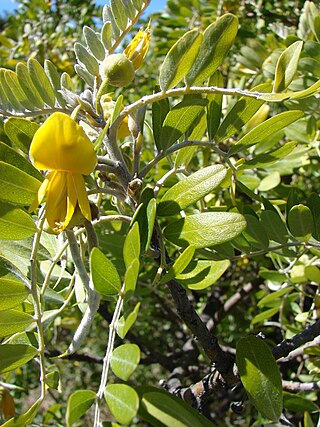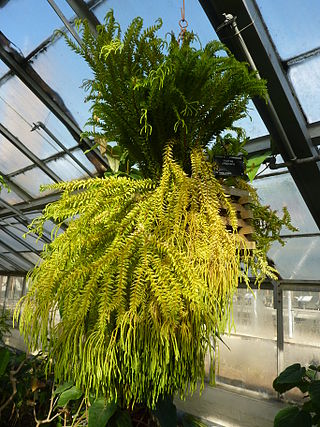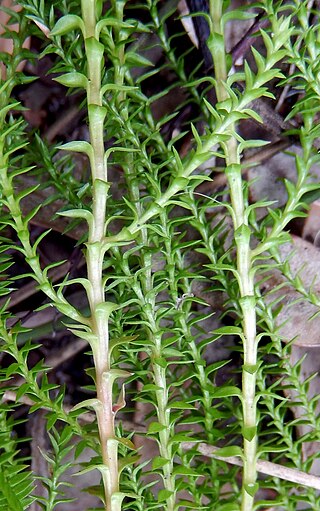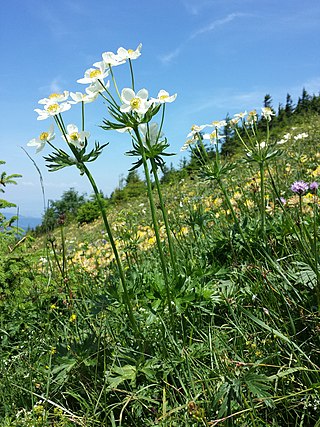
Thelypteridaceae is a family of about 900 species of ferns in the order Polypodiales. In the Pteridophyte Phylogeny Group classification of 2016, it is placed in the suborder Aspleniineae. Alternatively, the family may be submerged in a very broadly defined family Aspleniaceae as the subfamily Thelypteridoideae.

Huperzia is a genus of lycophyte plants, sometimes known as the firmosses or fir clubmosses; the Flora of North America calls them gemma fir-mosses. This genus was originally included in the related genus Lycopodium, from which it differs in having undifferentiated sporangial leaves, and the sporangia not formed into apical cones. The common name firmoss, used for some of the north temperate species, refers to their superficial resemblance to branches of fir (Abies), a conifer. As of 2020, two very different circumscriptions of the genus were in use. In the Pteridophyte Phylogeny Group classification of 2016, Huperzia is one of three genera in the subfamily Huperzioideae of the family Lycopodiaceae. Most species in the subfamily are placed in the genus Phlegmariurus. Huperzia is left with about 25 species, although not all have been formally transferred to other genera. Other sources recognize only Huperzia, which then has about 340 species.

The Lycopodiaceae are an old family of vascular plants, including all of the core clubmosses and firmosses, comprising 16 accepted genera and about 400 known species. This family originated about 380 million years ago in the early Devonian, though the diversity within the family has been much more recent. "Wolf foot" is another common name for this family due to the resemblance of either the roots or branch tips to a wolf's paw.

Sophora is a genus of about 45 species of small trees and shrubs in the pea family Fabaceae. The species have a pantropical distribution. The generic name is derived from sophera, an Arabic name for a pea-flowered tree.

Fallopia is a genus of about 12 species of flowering plants in the buckwheat family, often included in a wider treatment of the related genus Polygonum in the past, and previously including Reynoutria. The genus is native to temperate and subtropical regions of the Northern Hemisphere, but species have been introduced elsewhere. The genus includes species forming vines and shrubs.

Diphasiastrum is a genus of clubmosses in the plant family Lycopodiaceae. In the Pteridophyte Phylogeny Group classification of 2016, it is placed in the subfamily Lycopodioideae. It is closely related to the genus Lycopodium, and some botanists treat it within a broad view of that genus as a section, Lycopodium sect. Complanata. Some species superficially resemble diminutive gymnosperms and have been given common names such as ground-pine or ground-cedar.

Phlegmariurus is a genus of lycophyte plants in the family Lycopodiaceae. The genus is recognized in the Pteridophyte Phylogeny Group classification of 2016, but not by some other sources, which keep it in a broadly defined Huperzia.

Filago is a genus of plants in the sunflower family, native from Europe and northern Africa to Mongolia, Nepal, and Macaronesia. They are sometimes called cottonroses or cudweeds.

Anemonoides is a genus of flowering plants in the buttercup family Ranunculaceae. Plants of the genus are native to the temperate regions of the Northern Hemisphere, on the continents of North America, Europe, and Asia. The generic name Anemonoides means "anemone-like", a reminder that many of the species were formerly included within the genus Anemone.

Rostraria is a genus of plants in the grass family, native primarily to Eurasia and North Africa with one species native to South America. Hairgrass is a common name.

Tephroseris is a genus of Eurasian and North American plants in the groundsel tribe within the daisy family.

Cota is a genus belonging to the chamomile tribe within the sunflower family. It is native to Europe, North Africa, and southwestern Asia, with a few species naturalized elsewhere. It is an herbaceous plant with flower heads including white or yellow ray florets and yellow disc florets.

Diphasiastrum sitchense, the Sitka clubmoss, is a pteridophyte species native to northern North America and northeastern Asia. It is a terrestrial herb spreading by stolons running on the surface or the ground or just slightly below the surface. Leaves are appressed, broadly lanceolate, up to 3.2 mm long. Strobili are solitary on the ends of shoots. It is known from every province in Canada, plus the US States of Alaska, Oregon, Washington, Idaho, Montana, Maine, New Hampshire, Vermont, and New York. It is also found in Greenland, St. Pierre and Miquelon, Yukon, Japan, and the Kamchatka Peninsula of Asiatic Russia. It can be found in alpine meadows, open rocky barrens, and coniferous woodlands.

Pseudolycopodiella is a genus of non-seed plants in the Lycopodiaceae, long considered part of Lycopodium, but now recognized as a separate genus. It has 10–14 recognized species, only one in North America: Pseudolycopodiella caroliniana.

Lateristachys is a genus of lycophytes in the family Lycopodiaceae. In the Pteridophyte Phylogeny Group classification of 2016, it is placed in the subfamily Lycopodielloideae. Some sources do not recognize the genus, sinking it into Lycopodiella. Lateristachys species are native to the Philippines, Australia and New Zealand.

Palhinhaea is a genus of lycophytes in the family Lycopodiaceae. In the Pteridophyte Phylogeny Group classification of 2016, it is placed in the subfamily Lycopodielloideae. Some sources do not recognize the genus, sinking it into Lycopodiella. Palhinhaea species are widespread in the tropics and subtropics.

Austrolycopodium is a genus of lycophytes in the family Lycopodiaceae. In the Pteridophyte Phylogeny Group classification of 2016, it is placed in the subfamily Lycopodioideae. Some sources do not recognize the genus, sinking it into Lycopodium. Austrolycopodium species are mostly native to the temperate southern hemisphere.

Lycopodioideae is a subfamily in the family Lycopodiaceae in the Pteridophyte Phylogeny Group classification of 2016. It is equivalent to a broad circumscription of the genus Lycopodium in other classifications. Like all lycophytes, members of the Lycopodioideae reproduce by spores. The oldest fossils of modern members of the subfamily date to the Early Cretaceous.

Lycopodielloideae is a subfamily in the family Lycopodiaceae in the Pteridophyte Phylogeny Group classification of 2016. It is equivalent to a broad circumscription of the genus Lycopodiella in other classifications. Like all lycophytes, members of the Lycopodielloideae are vascular plants that reproduce by spores.

Anemonastrum is a genus of flowering plants in the family Ranunculaceae. Plants of the genus are native to the temperate and subarctic regions of North America, Greenland, Europe, Asia, South America, and New Zealand. The generic name Anemonastrum means "somewhat like anemone", a reference to the Anemone genus of closely related plants. It chiefly differs from Anemone in having a base chromosome number of x=7, as opposed to x=8.




















